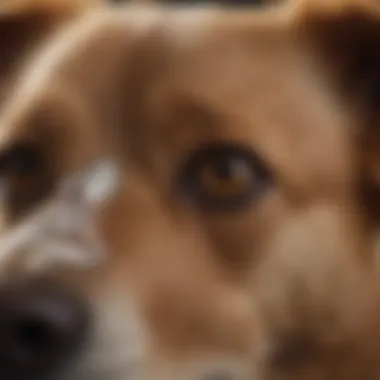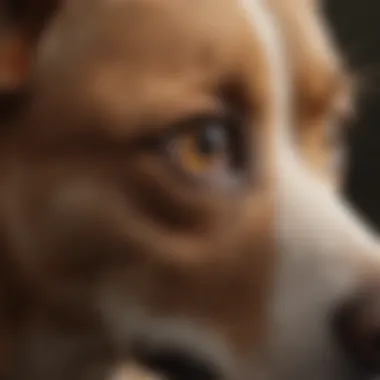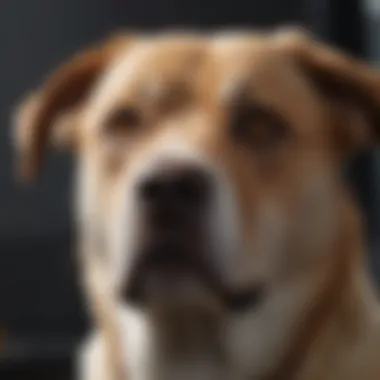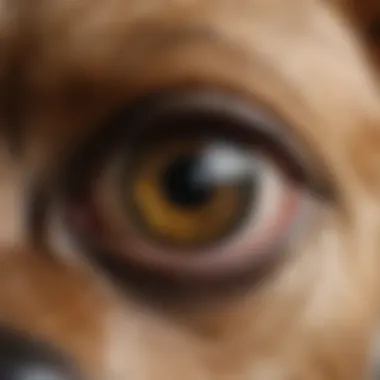Comprehensive Guide to Dog's Injured Eye Care and Recovery Strategies


Pet Care Essentials
Taking care of your pet's injured eye requires attention to detail and commitment. Daily nutrition requirements play a crucial role in promoting overall health and healing. Ensuring your dog receives a balanced diet rich in nutrients such as vitamins A and C can aid in the recovery process. Additionally, regular exercise and playtime not only keep your furry friend physically active but also contribute to their mental well-being, which is essential for a speedy recovery. When it comes to grooming, be gentle around the affected eye area, using specialized products recommended by your veterinarian to prevent irritation.
Behavior & Training
Understanding your pet's body language is key to discerning signs of discomfort or improvement. By observing subtle cues like excessive blinking or avoiding bright light, you can adjust your care routine accordingly. Implement basic training techniques to facilitate the administration of eye drops or medications, ensuring a stress-free experience for both you and your dog. Address behavioral concerns promptly by seeking professional guidance and applying positive reinforcement methods. Socialization tips post-injury should focus on gentle interactions to prevent any setbacks in the healing process.
Pet Home Environment
Creating a safe and comfortable environment is vital for your dog's recovery. Ensure your home is pet-friendly by removing potential hazards such as sharp objects or toxic plants that could harm your furry companion's injured eye. Choosing the right toys and accessories can also aid in keeping your pet occupied without exacerbating the injury. Setting up a cozy resting area away from high-traffic zones allows your dog to rest undisturbed, promoting healing and relaxation.
Pet Health Issues
Being vigilant about recognizing signs of illness post-injury is crucial. Look out for symptoms like excessive tearing, redness, or squinting, which may indicate underlying health concerns. Preventative care measures, such as regular veterinary check-ups and eye examinations, can help catch potential issues early on. Familiarize yourself with common eye ailments in dogs and their respective treatments to be better prepared in case of complications. Have an emergency preparedness plan in place, including contact information for veterinary services and directions to the nearest animal hospital in case of any unforeseen emergencies.
Understanding the Injury
Delving into the core of this guide, 'Understanding the Injury' plays a pivotal role in comprehending the complexities surrounding a dog's injured eye. This section sets the foundation by unveiling the common causes and signs that necessitate urgent attention. By shedding light on the intricacies of canine eye injuries, readers can grasp the urgency and importance of swift action. Understanding the injury empowers pet owners to make informed decisions, ensuring the well-being and recovery of their beloved companions.
Common Causes of Eye Injuries in Dogs
Foreign Object Entry
At the forefront of causes for eye injuries in dogs lies foreign object entry. Whether it be specks of dust, dirt particles, or debris, these intruders pose a significant threat to ocular health. Foreign object entry, a prevalent instigator of eye injuries, underscores the importance of maintaining a safe environment for pets. While exploring this aspect, it is evident that swift removal of foreign objects and prompt veterinary attention are imperative in mitigating further damage.
Scratches or Abrasions
The realm of eye injuries encompasses the often-overlooked realm of scratches or abrasions. Typically stemming from interactions with rough surfaces or sharp objects, these injuries can lead to discomfort and potential complications if left unattended. Recognizing the subtle signs of scratches or abrasions equips pet owners with the knowledge to seek timely interventions, emphasizing the significance of vigilance and swift action.
Trauma from Accidents
In a harsher spectrum, traumatic incidents result in eye injuries that demand immediate medical care. Whether due to a fall, collision, or impact, trauma from accidents underscores the fragility of ocular health in canines. Understanding the gravity of such incidents prompts pet owners to prioritize safety measures, thus averting potential risks and safeguarding their pet's visual well-being.


Infections
Completing the roster of common causes, infections emerge as silent adversaries in the realm of eye injuries. Resulting from bacteria, viruses, or fungi, ocular infections heighten the urgency for veterinary intervention. Exploring the nuances of infections highlights the importance of preventive measures and early detection in preserving a dog's ocular health, advocating for proactive care and vigilance.
Signs and Symptoms to Look Out For
Navigating the landscape of signs and symptoms synonymous with eye injuries, pet owners must familiarize themselves with red flags signaling ocular distress. Acknowledging these indicators is crucial in expediting diagnosis and treatment, safeguarding a pet's eyesight as a top priority.
Excessive Tearing
A hallmark symptom mirroring ocular discomfort, excessive tearing warrants attention due to its role as a visible indicator of potential issues. Understanding the nuances of excessive tearing aids pet owners in discerning abnormality from routine reactions, prompting timely intervention for the well-being of their companions. By recognizing the significance of this symptom, pet owners can align actionable steps with professional guidance for optimal outcomes.
Redness or Swelling
The emergence of redness or swelling signals underlying inflammation or trauma to the eye, necessitating closer examination and intervention. Detecting red flags such as redness or swelling urges pet owners to delve deeper into the root cause, enabling a proactive stance in addressing ocular concerns effectively. Acknowledging the implications of these symptoms instills a sense of urgency in seeking appropriate care and implementing tailored solutions for a pet's ocular health.
Squinting or Blinking Abnormally
An often subtle yet telling sign, squinting or blinking abnormally denotes ocular discomfort that requires prompt attention. By unraveling the significance of abnormal eye movements, pet owners can intervene early, averting potential complications and ensuring their pet's ocular well-being. Recognizing the gravity of this symptom empowers pet owners to act swiftly in partnership with veterinary professionals, orchestrating a comprehensive care regimen aimed at restoring ocular health.
Cloudiness in the Eye
The presence of cloudiness in a dog's eye signifies underlying issues ranging from cataracts to corneal abnormalities. Unveiling the veil of cloudiness prompts pet owners to engage in thorough monitoring and seek expert guidance promptly. By grasping the implications of ocular cloudiness, pet owners propel themselves towards optimal care strategies, uniting proactive measures with invaluable insights for preserving their pet's vision amidst potential challenges.
Seeking Veterinary Attention
When it comes to addressing a dog's injured eye, seeking veterinary attention is a crucial step in ensuring the well-being of your furry companion. Timely intervention by a professional veterinarian can make a significant difference in the outcome of the injury. Upon observing any signs or symptoms of eye distress, such as excessive tearing, redness, or cloudiness, it is imperative to seek immediate veterinary care to prevent further complications.
Importance of Prompt Veterinary Care
Preventing Further Damage
In the context of addressing a dog's injured eye, preventing further damage plays a pivotal role in promoting recovery and minimizing potential complications. By seeking prompt veterinary care, pet owners can mitigate the risk of exacerbating the existing injury. Timely intervention not only aids in safeguarding the dog's eye health but also facilitates a smoother treatment process by addressing issues swiftly and effectively.


Avoiding Infections
Another vital aspect of prompt veterinary care is avoiding infections. Injured eyes are susceptible to bacterial or fungal infections, which can impede the healing process and lead to more severe issues if left untreated. Veterinarians can prescribe appropriate medications to prevent infections and promote a sterile environment for optimal recovery.
Ensuring Proper Diagnosis
Prompt veterinary care also ensures proper diagnosis of the underlying cause of the eye injury. Through comprehensive examinations and diagnostic tests, veterinarians can pinpoint the specific issue affecting the eye and develop a tailored treatment plan. Proper diagnosis is crucial for effective treatment outcomes and personalized care tailored to the dog's individual needs.
Preparing for the Veterinary Visit
Gathering Medical History
Ahead of the veterinary visit, gathering the dog's medical history is paramount for providing comprehensive information to the veterinarian. Details regarding previous eye conditions, allergies, or medications can offer valuable insights into the dog's health background. By sharing accurate medical history, pet owners enable veterinarians to make informed decisions regarding treatment and care strategies.
Describing Symptoms
When preparing for the veterinary visit, describing the symptoms observed in the dog's injured eye is essential for accurate diagnosis. Information about when the symptoms started, their progression, and any changes noticed can aid veterinarians in identifying the underlying issue. Clear and detailed symptom description assists in guiding the diagnostic process and shaping the treatment plan.
Being Observant of Behaviors
During the veterinary visit, being observant of the dog's behaviors can provide additional clues about the eye injury. Observing whether the dog is avoiding light, rubbing or scratching the affected eye, or displaying unusual eye movements can assist veterinarians in assessing the severity of the injury. Monitoring the dog's behaviors helps veterinarians tailor their approach to treatment and address any specific concerns effectively.
Treatment Options
Treatment options for a dog's injured eye play a critical role in the comprehensive care and recovery process. When dealing with such a delicate issue, having a clear understanding of the available methods can significantly impact the outcome. Pet owners must be well-versed in the different avenues of treatment, their benefits, and any associated considerations to make informed decisions regarding their furry companion's health.
Medication and Eye Drops
Antibiotics for Infections
Antibiotics for infections stand out as an indispensable aspect of treating a dog's injured eye. These medications play a vital role in combating bacterial infections that may arise from injuries or foreign objects in the eye. The key characteristic of antibiotics is their ability to target and eliminate harmful bacteria effectively, preventing the spread of infection and promoting healing. While antibiotics can offer significant benefits by addressing the root cause of the issue, it is essential to be mindful of potential side effects and ensure proper dosage and administration.
Anti-inflammatory Medications


In the realm of eye injury treatment, anti-inflammatory medications emerge as essential tools in reducing swelling and alleviating discomfort. These medications work to control inflammation, which is a common response to trauma or infection in the eye. By reducing inflammation, these medications help enhance the healing process and improve overall comfort for the affected pet. Understanding the key characteristic of anti-inflammatory medications lies in their ability to target inflammation specifically, offering targeted relief without compromising the pet's well-being.
Pain Relief Solutions
Pain relief solutions hold significant importance in addressing a dog's injured eye, as pain management is crucial for the pet's comfort and well-being during recovery. These solutions aim to alleviate any discomfort or pain experienced by the pet, ensuring a smoother healing process. The unique feature of pain relief solutions lies in their ability to provide tailored relief, addressing the pet's individual pain levels and needs. While offering essential comfort, it is vital to monitor the pet's response to pain relief solutions and adjust accordingly to ensure optimal care.
Surgical Interventions
Corneal Repair Procedures
Corneal repair procedures are instrumental in restoring functionality and ensuring the long-term health of a dog's injured eye. These procedures are designed to address specific issues related to the cornea, such as damage from scratches or abrasions. The key characteristic of corneal repair procedures is their precision in targeting and repairing the affected area, promoting proper healing and minimizing complications. While these procedures offer significant benefits in restoring the eye's health, pet owners should be aware of potential risks and follow postoperative care guidelines meticulously to aid in successful recovery.
Enucleation as a Last Resort
Enucleation serves as a last resort in extreme cases where preserving the eye's health and function becomes unfeasible. This surgical intervention involves the removal of the affected eye to alleviate pain and prevent further complications. The key characteristic of enucleation lies in its effectiveness in addressing severe eye injuries that cannot be managed through other means. While enucleation may be a necessary step in certain situations, it is crucial for pet owners to weigh the decision carefully and consider the pet's well-being in the long term.
Postoperative Care Guidelines
After undergoing surgical interventions for a dog's injured eye, postoperative care guidelines play a crucial role in ensuring a smooth recovery process. These guidelines provide detailed instructions on wound care, medication administration, and monitoring for any signs of complications. The unique feature of postoperative care guidelines is their focus on holistic care, encompassing physical and emotional support for the pet throughout the recovery period. While adhering to these guidelines is essential for a successful recovery, vigilant monitoring and communication with the veterinary team are key to addressing any concerns promptly.
Home Care and Recovery
In addressing a dog's injured eye, Home Care and Recovery plays a pivotal role in supporting the healing process and ensuring the well-being of our furry friends. It encompasses various elements that are crucial for promoting recovery and comfort. Home Care and Recovery is essential to monitor the progress, prevent complications, and aid in the overall healing of the injured eye. By following the right protocols and providing a conducive environment, pet owners can significantly contribute to their dog's recovery.
Creating a Calm Environment
When it comes to Creating a Calm Environment for a dog with an injured eye, minimizing stimuli is of paramount importance. This involves reducing noise, bright lights, and excessive activity around the dog. Minimizing stimuli helps in lowering stress levels and promoting relaxation, which are vital for the healing process. Creating a soothing atmosphere by minimizing stimuli can aid in reducing anxiety and discomfort for the dog, facilitating a quicker recovery.
Ensuring Rest
Part of creating a calm environment for a dog's injured eye is Ensuring Rest. Rest is crucial for the body to allocate energy towards healing the injured eye. By ensuring that the dog gets ample rest, pet owners provide the necessary conditions for the eye to recover effectively. Rest allows the eye muscles to relax, reduces strain, and promotes optimal conditions for healing. Ensuring proper rest can expedite the healing process and improve the dog's overall comfort.
Maintaining Cleanliness
Closely tied to the recovery process is Maintaining Cleanliness around the dog's injured eye. Keeping the area clean is essential to prevent infections and further complications. Maintaining cleanliness involves gently cleaning around the eye, removing any discharge or debris carefully. Proper hygiene can help in reducing the risk of secondary infections and promote a hygienic environment for the healing eye. Maintaining cleanliness is a fundamental aspect of home care that contributes to the overall recovery and well-being of the dog.
Administering Medications at Home
Administering Medications at Home is a crucial aspect of caring for a dog's injured eye during the recovery process. Following dosage instructions accurately is imperative to ensure the effectiveness of the medications and promote healing. Monitoring the progress of the eye's recovery helps in assessing the effectiveness of the medications and making any necessary adjustments. Addressing any side effects promptly is essential to prevent complications and ensure the well-being of the dog. Administering medications at home requires attentiveness and adherence to the prescribed regimen to support the dog's recovery journey.







